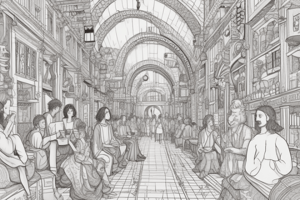Podcast
Questions and Answers
What is a common characteristic shared by both modernism and postmodernism?
What is a common characteristic shared by both modernism and postmodernism?
- A focus on traditional values and dogmas
- A rejection of absolute truths (correct)
- An emphasis on clarity and definiteness
- A search for universal grand narratives
What is the primary driving force behind the emergence of modernism in the late 19th and early 20th centuries?
What is the primary driving force behind the emergence of modernism in the late 19th and early 20th centuries?
- The decline of the aristocracy
- The search for universal grand narratives
- The rise of industrialization and urbanization (correct)
- The emergence of new forms of art and literature
What is the primary focus of modernist expression?
What is the primary focus of modernist expression?
- The capture of fragmentation and ambiguity in modern life (correct)
- The rejection of traditional values and dogmas
- The exploration of grand narratives
- The creation of universal truths and absolute values
What is the primary critique of modernism by postmodernism?
What is the primary critique of modernism by postmodernism?
What is the primary characteristic of postmodernism's skepticism towards grand narratives?
What is the primary characteristic of postmodernism's skepticism towards grand narratives?
What is the primary difference between modernism and postmodernism in terms of their attitudes towards fragmentation and ambiguity?
What is the primary difference between modernism and postmodernism in terms of their attitudes towards fragmentation and ambiguity?
What is a key characteristic of postmodernism that distinguishes it from modernism?
What is a key characteristic of postmodernism that distinguishes it from modernism?
What do modernism and postmodernism have in common?
What do modernism and postmodernism have in common?
What is the role of the individual in postmodernism?
What is the role of the individual in postmodernism?
What is the impact of modernism and postmodernism on art, literature, and culture?
What is the impact of modernism and postmodernism on art, literature, and culture?
How do modernism and postmodernism differ in their approach to tradition?
How do modernism and postmodernism differ in their approach to tradition?
What is the tone of postmodernism towards established power structures and ideologies?
What is the tone of postmodernism towards established power structures and ideologies?
Flashcards are hidden until you start studying
Study Notes
Modernism and Postmodernism: A Brief Overview
Modernism and postmodernism are two significant artistic, cultural, and intellectual movements that emerged in the 20th century. These movements, while distinct, often overlap in their themes and ideas. Modernism, which originated in the late 19th and early 20th centuries, is characterized by a rejection of traditional values and a focus on individual expression, innovation, and the search for new forms of art and literature. Postmodernism, on the other hand, emerged in the mid-20th century and is marked by a skepticism towards grand narratives, a rejection of absolute truths, and an emphasis on fragmentation, ambiguity, and irony.
Modernism
Modernism is a cultural movement that encompasses architecture, art, literature, and music. It emerged in the late 19th and early 20th centuries as a response to the rapid changes brought about by industrialization and urbanization. Modernists sought to reject traditional forms and values in favor of new, innovative forms of expression. They embraced the fragmentation and ambiguity of modern life and sought to capture this in their works. Modernism was marked by a focus on individual expression, the search for new forms of art and literature, and a rejection of traditional values and dogmas.
Postmodernism
Postmodernism emerged in the mid-20th century as a response to the failures of modernism and the broader cultural and social changes of the time. Unlike modernism, postmodernism is marked by a skepticism towards grand narratives and absolute truths. Postmodernists reject the idea of a single, authoritative interpretation of reality and instead emphasize the importance of multiple perspectives and the role of the individual in constructing meaning. Postmodernism is characterized by a rejection of absolute truths, a focus on fragmentation and ambiguity, and an ironic and critical stance towards established power structures and ideologies.
Comparison and Overlap
While modernism and postmodernism are distinct movements, they often overlap in their themes and ideas. Both movements reject traditional values and seek to capture the fragmentation and ambiguity of modern life. They both emphasize the importance of individual expression and the role of the artist or writer in constructing meaning. However, where modernism often sought to break with tradition and establish new forms of expression, postmodernism is marked by a skepticism towards grand narratives and a rejection of absolute truths.
Impact and Legacy
Modernism and postmodernism have had a profound impact on art, literature, and culture. They have influenced the way we perceive the world around us and the way we construct meaning from our experiences. Both movements continue to shape our cultural and intellectual landscape, and their ideas and influences can be seen in many of the works of art, literature, and other cultural productions that continue to be produced today.
In conclusion, modernism and postmodernism are two significant movements that emerged in the 20th century and continue to shape our cultural and intellectual landscape. While distinct, they often overlap in their themes and ideas, and their impact on art, literature, and culture continues to be felt today.
Studying That Suits You
Use AI to generate personalized quizzes and flashcards to suit your learning preferences.



